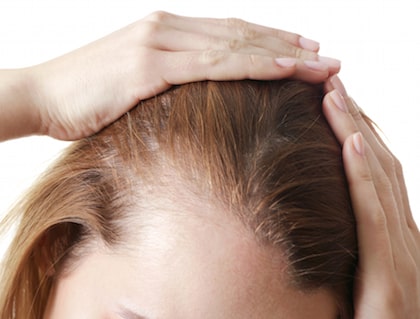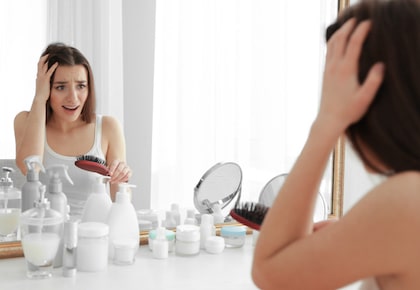For years, hair loss has been perceived by the public as a medical issue that mainly impacts male patients. There are many people that do not seem to be aware of the fact that a large number of female patients also suffer from loss of hair on their scalp. There are a number of reasons for female hair loss and they include the aging process making changes to the hairline and also changes that occur to the hormone levels of a female. While female hair loss is not always acknowledged by the public, there are a number of treatment options available to help women suffering from this condition. Let’s take a look at popular female hair loss treatment options available to patients all across the United States.
Female Hair Loss Treatment Options
 Hormone therapy can treat hair loss if the loss of hair is the result of hormone imbalances. An example of the type of imbalances that patients can go through is menopause. Popular hormone therapy treatment choices include birth control pills or hormone replacement therapy.
Hormone therapy can treat hair loss if the loss of hair is the result of hormone imbalances. An example of the type of imbalances that patients can go through is menopause. Popular hormone therapy treatment choices include birth control pills or hormone replacement therapy.- Minoxidil is an FDA-approved medication that treats hair loss that is sold under the name Rogaine. The product can be purchased at pharmacies as an over the counter medication. It is used by patients to stimulate the growth of hair and it is also able to extend the total hair growth cycle. Plus, minoxidil thickens the appearance of the hair on the scalp which reduces the look of balding areas. Minoxidil is supposed to be used daily. Studies have shown that 2% minoxidil is the most effective option to treat female patients that have pattern baldness on the scalp. While minoxidil can be used to stimulate the growth of hair, it will need to be used consistently in order to maintain the desired results. If a person decides to stop using the medication on a regular basis, the results will begin to disappear and the hair will eventually return to its former condition.
- Corticosteroids injections are an effective hair loss treatment option for patients that suffer from conditions such as alopecia areata. This is a hair loss condition where the hair falls out of the scalp in what can best be described as a patchy appearance. It has been reported that the injection of corticosteroids directly into the areas of the scalp lacking in hair can encourage the growth of new hair. Topical corticosteroids are also available as lotions and creams for patients that do not want to have injections in the scalp.
- Hair transplant has been shown to be the most effective and natural looking method of treating hair loss in a patient. The hair restoration surgeon takes hair from the donor area of the body and moves it to the areas of the scalp that are balding. The donor area of the scalp is usually located on the back and sides of the scalp. The hair from the donor area is resistant to balding which means the transplanted hair will not fall out once it is transplanted to the area of the scalp that is lacking in hair.
- Hair loss shampoo has been shown to treat minor hair loss issues that are the result of something as simple as clogged pores that are located on the scalp. Medicated hair loss shampoo works to clear dead skin cells from the pores. The dead skin cells need to be cleared in order to promote healthy hair growth.
- A healthy diet is a diet filled with fruits and vegetables. This diet choice means people will get a good amount of vitamins and nutrients that, in turn, will help them enjoy a healthy head of hair. A healthy diet can also help female patients that suffer from an iron deficiency enjoy healthier hair since an iron deficiency can contribute to the suffering from hair loss.
Female Hair Loss Causes and Consultation Appointment
 A common cause of hair loss in females is androgenetic alopecia. With this condition, the age where hair loss begins can range anywhere from early 20s to the age of 40 (or older). Females with androgenetic alopecia often see the hair part, located at the center of the hair; start to become wider in its appearance. These female hair loss patients could also see patchy balding areas and thinning hair that is a result of a shorter hair life cycle. The hair loss will become more noticeable by others as time passes and the condition continues to expand.
A common cause of hair loss in females is androgenetic alopecia. With this condition, the age where hair loss begins can range anywhere from early 20s to the age of 40 (or older). Females with androgenetic alopecia often see the hair part, located at the center of the hair; start to become wider in its appearance. These female hair loss patients could also see patchy balding areas and thinning hair that is a result of a shorter hair life cycle. The hair loss will become more noticeable by others as time passes and the condition continues to expand.
In addition to androgenetic alopecia, females can see hair loss that is the result of inflammatory conditions that impact the scalp and the hormone imbalances discussed earlier in this article.
Female Hair Loss Consultation Appointment
Female hair loss patients should schedule a consultation appointment with a board-certified doctor who has both experience in performing female hair transplant and the necessary knowledge about female hair loss conditions. The doctor will examine the patient to determine the cause of the hair loss. The surgeon will also create a treatment plan designed to address the current amount of balding and also prevent any future hair loss.
MA